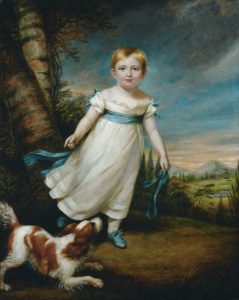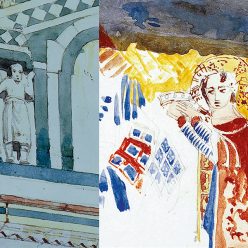In 1822, at the age of three and a half, Ruskin was taken to the London studio of James Northcote to sit for his portrait. We know about the making of this picture because more than half a century afterwards Ruskin wrote about it, in an instalment of Fors Clavigera (1871–84) which he later incorporated into his autobiography Praeterita (1885–9). Northcote was seventy-six when the portrait was painted: as Ruskin describes him in retrospect he is emphatically old, ‘old Mr Northcote’, ‘the old painter’. Ruskin himself was fifty-six when he recalled this episode in Fors, and ten years older when the opening chapters of Praeterita were published. In various ways this memory of the portrait offers a tiny emblem of the work of autobiography: staging, and restaging, the continuing encounter between youth and age, self and others, that culminates in the autobiographer’s encounter with his own child-self, and locating the origins of adult qualities and accomplishments, the well-springs of character (often, for Ruskin, associated with real remembered wells and springs).
The immediate context for the portrait sitting in the first chapter of Praeterita is Ruskin’s consideration of his very early upbringing. He was generally left to his own devices by his mother, so long as he was ‘neither fretful nor troublesome’: he recalls being ‘always summarily whipped if I cried, did not do as I was bid, or tumbled on the stairs’. He was allowed only the simplest toys (a ball, a bunch of keys, some wooden bricks), and was strictly required to occupy himself: ‘the law was, that I should find my own amusement’. As a consequence, by his fourth year he was content to pass a day at home in Brunswick Square, Bloomsbury by ‘tracing the squares and comparing the colours of my carpet;—examining the knots in the wood of the floor, or counting the bricks in the opposite houses’. Without quite saying so, Ruskin is describing an education in looking, patiently and closely and accurately. And he tells us that his eye for visual detail was so acute that when he was brought for the first time to Northcote’s studio in Argyll Street, Soho ‘I had not been ten minutes alone with him before I asked him why there were holes in his carpet’.

by James Northcote
oil on linen, 1822
NPG 5973
© National Portrait Gallery, London
The intensity of the child’s gaze is funny but also disconcerting: he is there to be looked at, after all. As the passage continues, too, Ruskin brings to bear the grown-up version of that faculty, turning the practised gaze of an art-critic and teacher on Northcote’s work in the past, and good-naturedly picking holes in it. Looking at the portrait now he sees ‘a very pretty child with yellow hair, dressed in a white frock like a girl, with a broad light-blue sash and blue shoes to match; the feet of the child wholesomely large in proportion to its body; and the shoes still more wholesomely large in proportion to the feet’. Those sound like faults of proportion, noted with amusement; but more striking in the picture than the relative size of body, feet, and shoes is the perfect stillness of the child’s head atop a rushing body. As Ruskin notes, ‘I am represented as running in a field at the edge of a wood with the trunks of its trees striped across in the manner of Sir Joshua Reynolds; while two rounded hills, as blue as my shoes, appear in the distance’. Surely he means he was misrepresented as doing so: the romping pose is no more faithful to sitter or occasion than is Northcote’s reproduction of the mannerisms of the artist who had been his own teacher a generation before. And indeed Ruskin notes that Northcote found him a convenient sitter exactly because of his stillness, his ability to remain ‘contentedly motionless, counting the holes in his carpet’; a quality visible in the finished portrait only in the placid immobility of the child’s expression, unmoved even by the little dog in the foreground who so clearly wants to play with him, and about whom the grown-up Ruskin, oddly, says nothing at all.
He does tell us that the hills in the background ‘were put in by the painter at my own request’, and that he had asked specifically for blue hills, not so that they should match his shoes but because ‘I had already been once, if not twice, taken to Scotland; and my Scottish nurse having always sung to me as we approached the Tweed or Esk,—
“For Scotland, my darling, lies full in thy view,
With her barefooted lassies, and mountains so blue,”
the idea of distant hills was connected in my mind with approach to the extreme felicities of life, in my Scottish aunt’s garden of gooseberry bushes, sloping to the Tay.’ The river at the bottom of that garden, Ruskin has already told us in this chapter, ran ‘clear-brown over the pebbles three or four feet deep; swift-eddying,—an infinite thing for a child to look down into’. It is one of many streams that flow through the early pages of Praeterita, affording the young Ruskin ‘occasional glimpses of the rivers of Paradise’: ‘the delicious dripping’ after the water-carts were filled from a stand-pipe in Brunswick Square; ‘the spring of crystal water at the back door’ of another aunt’s house at Croydon; ‘the cress-set rivulets in which the sand danced and minnows darted above the Springs of Wandel’. The couplet endearingly repeated by Ruskin’s nurse comes from Robert Bloomfield’s ‘Song, For a Highland Drover returning from England’ (1801), a cattle-drover’s joyful apostrophe to the River Tweed on a homeward journey through the Scottish Borders. Yet when the Ruskins visited Scotland they both were and were not returning from England, and his aunt’s house at Perth was not home for Ruskin: home, rather, already, seems to have been no place in particular but just the visible, whatever lay full in his view, the infinite felicity of moving water, the mountains rising before him.
Oliver Herford is Birmingham Fellow in Literature of the Long Nineteenth Century at the University of Birmingham, where he co-directs the Centre for Literary Editing and the Materiality of the Text. He is the author of Henry James’s Style of Retrospect: Late Personal Writings, 1890–1915 (OUP, 2016) and a number of articles on related aspects of James’s non-fictional style, and is currently editing the Prefaces to the New York Edition for the Cambridge Edition of The Complete Fiction of Henry James (CUP, forthcoming). He was President of the Henry James Society for 2018. Oliver has also published on the links between portraiture, letter-writing and life-writing in the circle of John Keats, and his next research project will be a study of nineteenth-century literary correspondence.
